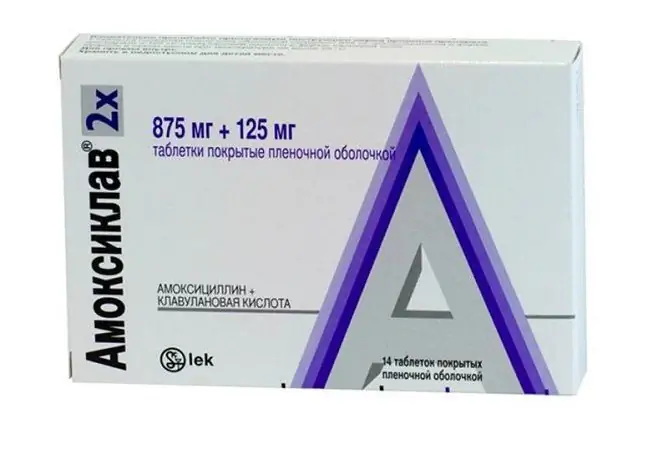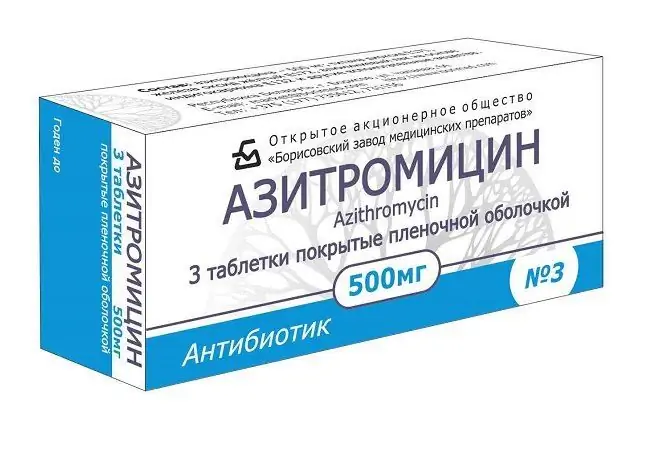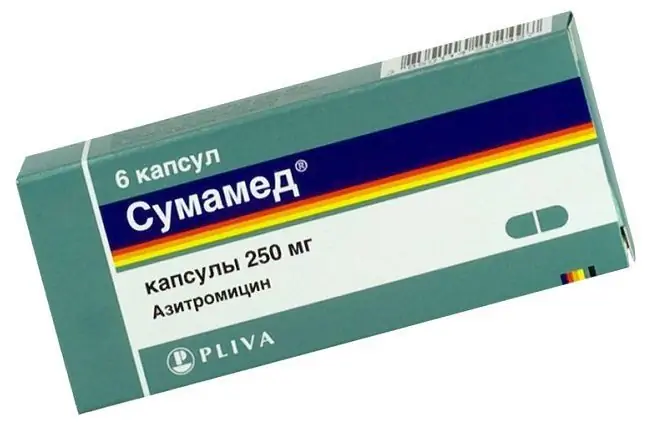- Author Rachel Wainwright [email protected].
- Public 2023-12-15 07:39.
- Last modified 2025-11-02 20:14.
Amoxiclav for angina for an adult: dosage, contraindications
The content of the article:
- Benefits of Amoxiclav
-
Ways of using Amoxiclav
Amoxiclav for angina in children
- Contraindications to the use of the drug
- Video
Amoxiclav for angina is often prescribed for bacterial lesions of the palatine tonsils, in which an important etiological role belongs to group A beta-hemolytic streptococcus, or pyogenic streptococcus.

One of the most commonly used drugs for purulent sore throat - Amoxiclav
The drugs of choice in the fight against streptococcal tonsillitis are penicillins. Since the resistance of pathogens to the antibacterial agents most often used in outpatient and hospital practice determines the development of unfavorable outcomes of patient treatment and is a predisposing factor in the development of purulent-septic and rheumatic complications, it is very important to correctly select and use drugs for the initial therapy of angina.
Benefits of Amoxiclav
The high sensitivity of beta-hemolytic streptococcus and a number of gram-positive and gram-negative pathogenic microorganisms to amoxicillin is unpromising due to the ability of some bacteria, including opportunistic pathogens, to produce the enzyme beta-lactamase, which destroys the antibiotic.
Therefore, it seems more reliable to take amoxicillin in combination with clavulanic acid. Both components are contained in the drug Amoxiclav. It is a broad-spectrum bactericidal antibiotic.
Amoxicillin is a semi-synthetic penicillin (beta-lactam antibiotic). Its mechanism of action is to inhibit one or more enzymes on the pathway of biosynthesis of peptidoglycan, which is the main structural component of the bacterial cell wall. Inhibition of peptidoglycan synthesis leads to a loss of cell wall strength, which usually leads to lysis and death of pathogen cells.
Amoxicillin is active against a large number of pathogenic bacteria, but its spectrum of activity does not include microorganisms that produce beta-lactamase enzymes.
Clavulanic acid, which is part of Amoxiclav, is a beta-lactam that is structurally related to penicillins. The acid inhibits some beta-lactamases, preventing the inactivation of amoxicillin, which contributes to the expansion of its spectrum of activity, including bacteria that are usually resistant to penicillins and cephalosporins.
At the same time, clavulanic acid itself does not have antibacterial properties.
Amoxiclav has a bactericidal effect on gram-positive aerobes (group A beta-hemolytic streptococcus, Staphylococcus aureus, pneumococcus), gram-negative aerobes (Escherichia coli, enterobacteria, Haemophilus influenzae, Klebsiella, Moraxella).

Amoxiclav has a bactericidal effect on gram-positive and gram-negative aerobes
Also, Amoxiclav is active against anaerobes (clostridia, peptostreptococci, bacteroids, fusobacteria) and obligate intracellular microorganisms (chlamydia) and spirochetes (treponema pale).
A wide range of antibacterial action of the drug is very important due to the spread of combined infection of the mucous membrane of the oropharynx with several types of pathogenic bacteria.
It is important to remember that Amoxiclav, like other antibiotics, does not act on viruses. Therefore, for the treatment of acute tonsillitis of viral etiology, it is necessary to prescribe antiviral agents.
The drug is available in the form of film-coated tablets, powder for suspension for oral administration, powder for solution for intravenous administration, and dispersible tablets.
The antibiotic is characterized by excellent pharmacokinetic properties: high bioavailability, rather long half-life (6-8 hours), which provides high concentrations of active substances in the blood, as well as good penetration into mucous membranes and ENT organs.
After oral administration, the drug is rapidly and completely absorbed from the gastrointestinal tract. The components of the drug are excreted by the kidneys in the urine.
Ways of using Amoxiclav
The method of administration of the drug depends on the severity of the disease: in severe patients with severe symptoms of intoxication in the form of febrile fever, adynamia, shortness of breath, Amoxiclav is administered intravenously. Also, this method is indicated for violation of swallowing due to pain syndrome, unwillingness to drink medicine, the presence of purulent complications, a long course of the disease without positive dynamics.
In other cases, pills are preferable.
Depending on the form of the disease, the dosage of Amoxiclav for angina for an adult is selected individually by the attending physician. In this case, the doctor takes into account the age, body weight, functional state of the patient's kidneys and the severity of angina.
For better absorption, it is recommended to take the tablets at the beginning of a meal. It also helps to reduce the side effects of the digestive system.
The course of treatment is 5 to 14 days. The duration of antibiotic use is determined by the attending physician individually.
It is not recommended to independently choose or change the dosage of the drug, set the timing of therapy, stop taking if you feel better, or prolong the treatment without first consulting a specialist. This can lead to the development of side reactions and numerous complications.
Amoxiclav for angina in children
For children, the dose of the drug is calculated taking into account the age, weight of the child and the severity of the condition. The recommended regimen is 40 mg per kg per day in 3 divided doses.

For children, Amoxiclav is prescribed in the form of a suspension
For children under 6 years old, especially for children under one year old, it is more preferable to take a suspension.
The maximum daily dose of amoxicillin for children is 45 mg / kg, while for adults it is 6000 mg per day.
Contraindications to the use of the drug
Before prescribing Amoxiclav, the doctor must make sure that the patient has no individual intolerance, episodes of sensitization to penicillin drugs and cephalosporins in history. The presence of an allergic reaction is an absolute contraindication to antibiotic prescription.
Other diseases / conditions in which therapy is contraindicated:
- dysfunction of the liver caused by taking amoxicillin in history;
- renal failure;
- Infectious mononucleosis;
- lymphocytic leukemia.
To avoid possible side effects from the intestines (diarrhea, constipation), it is recommended to restore microflora after a course of antibiotic therapy by using complex preparations with lacto- and bifidobacteria. Living beneficial microorganisms in the composition of these funds (Acipol, Linex) help to quickly restore the balance of intestinal microflora.
The numerous positive reviews received from doctors and patients about Amoxiclav with angina confirm its effectiveness and reliability.
After verification of the pathogen by bacteriological inoculation of the discharge from the mucous membrane of the palatine tonsils and the posterior pharyngeal wall, the drug selected in the starting antibiotic therapy scheme can be changed depending on the sensitivity of the pathogen obtained. But given the results of numerous studies, it remains advisable to prescribe Amoxiclav as a first-line antibiotic for acute bacterial tonsillitis.
Video
We offer for viewing a video on the topic of the article.

Alina Ervasova Obstetrician-gynecologist, consultant About the author
Education: First Moscow State Medical University. THEM. Sechenov.
Work experience: 4 years of work in private practice.
Found a mistake in the text? Select it and press Ctrl + Enter.






